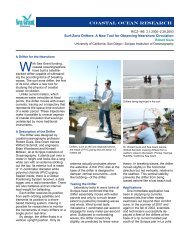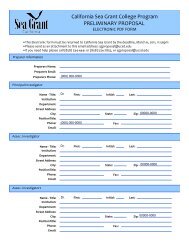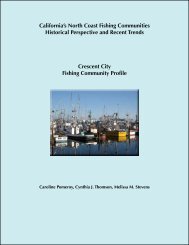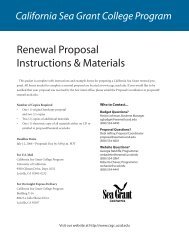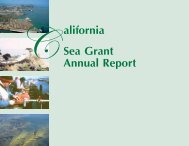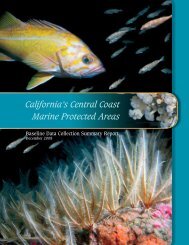PAT-UC Covers - California Sea Grant - UC San Diego
PAT-UC Covers - California Sea Grant - UC San Diego
PAT-UC Covers - California Sea Grant - UC San Diego
Create successful ePaper yourself
Turn your PDF publications into a flip-book with our unique Google optimized e-Paper software.
grow onto human bone to heal terrible<br />
wounds. These scenarios are not so farfetched,<br />
as recent <strong>Sea</strong> <strong>Grant</strong> research led<br />
by Daniel Morse of <strong>UC</strong> <strong>San</strong>ta Barbara is<br />
proving. Researchers have characterized<br />
the molecular mechanism controlling the<br />
nanofabrication of spicules, tiny silicabased<br />
structures that together form the<br />
“skeleton” of a sponge. The scientists have<br />
found that a single protein, which they<br />
named “silicatein,” directs the formation<br />
of ceramic-like silica composites. These<br />
composites are precisely arranged and<br />
remarkably strong – properties that are<br />
attractive starting points for designing<br />
new electronic, optical and medical<br />
materials. At present, silicon and oxygen<br />
polymers are manufactured under intense<br />
heat, pressure, or acidity to produce<br />
glass, resins, semiconductors, and optical<br />
fibers. The discovery of a natural pathway<br />
for synthesizing silicon-based materials<br />
opens the door for new, less costly and<br />
environmentally cleaner ways of producing<br />
the next generation of high-tech materials.<br />
microwires of silica – an achievement that has excited the private sector because<br />
of its potential application in the development of new photonic devices such as<br />
semiconductors and LEDs. Morse is now collaborating with researchers from Dow<br />
Corning Corporation and the Los Alamos National Laboratory to further examine<br />
the potential applications of his <strong>Sea</strong> <strong>Grant</strong> research.<br />
This is an ascidian of the Genus Didemnum collected in a small village in Brazil. This animal<br />
contains a series of very potent cancer cell growth inhibitors which have been useful in the<br />
cancer drug discovery process. (Photo W. Fenical)<br />
Novel Protein Polymer<br />
Robert Shadwick of Scripps Institution of Oceanography and his team have<br />
characterized the biomechanical properties of protein polymers in marine snail egg<br />
capsules. Their tests have shown that the polymer has “self-healing” properties. It can<br />
be stretched and re-stretched without tearing. The discovery of a strong yet elastic<br />
material could help build better soft-tissue transplant material such as artificial<br />
tendons and ligaments for treating joint injuries.<br />
This is Pseudopterogorgia elisabethae,<br />
a soft-coral from the Caribbean <strong>Sea</strong>.<br />
<strong>UC</strong> researchers developed a novel<br />
skin care additive from this animal<br />
that is in wide use today. The additive<br />
eliminates the allergenic response<br />
some users experience to common<br />
skin care products. (Photo W. Fenical)<br />
In other work, Morse and his team have<br />
developed catalysts that mimic the action<br />
of silicatein, and the technology has since<br />
been patented. More recently, they use the<br />
catalysts, in conjunction with a unique<br />
fluorescent precursor, to make fluorescent<br />
23<br />
<strong>California</strong> <strong>Sea</strong> <strong>Grant</strong>: 1998-2003



